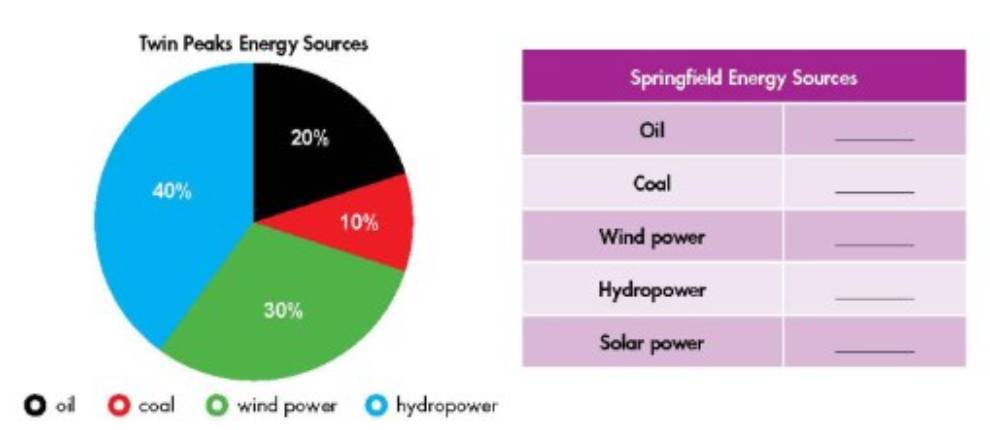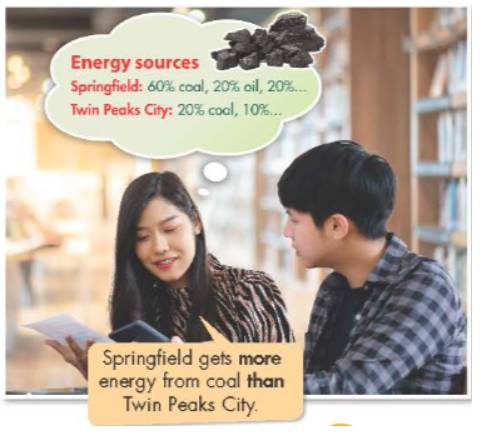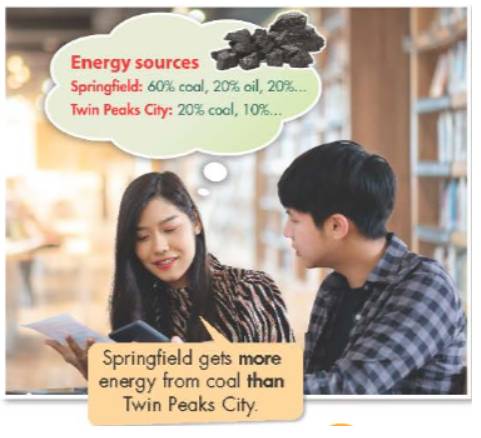Hãy nhập câu hỏi của bạn vào đây, nếu là tài khoản VIP, bạn sẽ được ưu tiên trả lời.

A: How much energy does Springfield get from oil?
(Springfield nhận được bao nhiêu năng lượng từ năng lượng thủy điện?)
B: It gets fifty percent from oil.
(Nó nhận được 50% từ năng lượng dầu.)
A: What about energy from coal?
(Còn năng lượng từ than đá thì sao?)
B: Springfield gets twenty percent from coal.
(Springfield nhận được 20% từ than.)
A: How much energy does Springfield get from wind power?
(Springfield nhận được bao nhiêu năng lượng từ năng lượng gió?)
B: Springfield gets five percent from wind power.
(Springfield nhận được 5% từ năng lượng gió.)
A: How much energy does Springfield get from hydropower?
(Springfield nhận được bao nhiêu năng lượng từ năng lượng thủy điện?)
B: Springfield gets five percent from hydropower.
(Springfield nhận được 5% từ năng lượng thủy điện.)
A: How much energy does Springfield get from solar power?
(Springfield nhận được bao nhiêu năng lượng từ năng lượng mặt trời?)
B: Springfield gets twenty percent from solar power.
(Springfield nhận được 20% từ năng lượng mặt trời.)
Springfield Energy Sources (Các nguồn năng lượng của Springfield) | |
Oil (dầu mỏ) | 50% |
Coal (than đá) | 20% |
Wind power (năng lượng gió) | 5% |
Hydropower (thủy điện) | 5% |
Solar power (năng lượng mặt trời) | 20% |

2. Does Highdale burn more natural gas than Wintertown?
(Highdale có đốt cháy nhiều khí đốt tự nhiên hơn Wintertown không?)
3. Springfield gets 40% less energy from solar power than Twin Peaks.
(Springfield nhận được năng lượng từ năng lượng mặt trời ít hơn 40% so với Twin Peaks.)
4. People in Springfield use more electricity than people in Twin Peaks.
(Người dân ở Springfield sử dụng nhiều điện hơn người dân ở Twin Peaks.)
5. Does Greenwood get more energy of its from coal than Maple Falls?
(Greenwood có nhận được nhiều năng lượng từ than đá hơn Thác Maple không?)

A: What sources of energy does your country use?
(Quốc gia của bạn sử dụng những nguồn năng lượng nào?)
B: My country use energy from water, sun, oil and coal.
(Nước tôi sử dụng năng lượng từ nước, mặt trời, dầu mỏ và than đá.)
A: Do you think it uses more non-renewable or renewable energy?
(Bạn có nghĩ rằng nó sử dụng năng lượng không thể tái tạo hoặc tái tạo nhiều hơn?)
B: I think it use more non-renewable energy.
(Tôi nghĩ nó sử dụng nhiều năng lượng không thể tái tạo hơn.)

2. Natural gas is cheap, but it is excellent for cooking.
3. The power plant is big and it provides enough power for the whole town.
4. The solar panels are expensive to buy, but they save money in electricity bills later.
5. My father loves a coal fire but I hate it.
6. I don't think we should use nuclear power, but my brother thinks using it is a good idea.
2. Natural gas is cheap, but it is excellent for cooking.
(Khí ga tự nhiên rẻ, nhưng nó rất tuyệt khi nấu ăn.)
3. The power plant is big and it provides enough power for the whole town.
(Nhà máy điện lớn và nó cung cấp đủ năng lượng cho cả thị trấn.)
4. The solar panels are expensive to buy, but they save money in electricity bills later.
(Các tấm pin mặt trời rất tốn kém để mua, nhưng chúng tiết kiệm tiền trong hóa đơn tiền điện sau này.)
5. My father loves a coal fire, but I hate it.
(Bố tôi thích lửa than nhưng tôi ghét nó.)
6. I don't think we should use nuclear power, but my brother thinks using it is a good idea.
(Tôi không nghĩ chúng ta nên sử dụng năng lượng hạt nhân, nhưng anh trai tôi nghĩ rằng sử dụng nó là một ý tưởng tốt.)

1. There are two energy sources. They are non-renewable sources and renewable sources.
(Có hai nguồn năng lượng. Chúng là những nguồn không thể tái tạo và những nguồn có thể tái tạo.)
2. Non-renewable sources are coal, oil and natural gas.
(Các nguồn không thể tái tạo là than đá, dầu mỏ và khí đốt tự nhiên.)
3. Renewable sources are available, clean and safe to use. But they are expensive to produce.
(Nguồn tái tạo có sẵn, sạch sẽ và an toàn để sử dụng. Nhưng chúng đắt tiền để sản xuất.)
4. In the future we will rely more on renewable energy sources.
(Trong tương lai, chúng tôi sẽ dựa nhiều hơn vào các nguồn năng lượng tái tạo.)

1. Solar panel | 2. power plant | 3. renewable | 4. pollution |
5. natural gas | 6. Non-renewable | 7. Nuclear power | 8. wind turbines |
1. Solar panels are expensive to buy, but they save a lot of money by taking energy from the sun.
(Các tấm pin mặt trời đắt tiền để mua, nhưng chúng tiết kiệm rất nhiều tiền bằng cách lấy năng lượng từ mặt trời.)
2. He works at a coal power plant. It produces the electricity for Springfield Town.
(Anh ấy làm việc ở nhà máy điện than. Nó sản xuất điện cho Thị trấn Springfield.)
3. The good thing about renewable energy like solar power is that it never runs out.
(Cái hay của năng lượng tái tạo như năng lượng mặt trời là nó không bao giờ cạn kiệt.)
4. Non-renewable energy sources like coal causes a lot of pollution which is bad for the environment.
(Các nguồn năng lượng không tái tạo như than đá gây ra nhiều ô nhiễm môi trường.)
5. My cooker uses natural gas. We have to replace the bottles twice a year.
(Bếp của tôi sử dụng gas tự nhiên. Chúng tôi phải thay thế các chai hai lần một năm.)
6. Non-renewable sources like coal and oil cannot last forever.
(Các nguồn không thể tái tạo như than đá và dầu mỏ không thể tồn tại mãi mãi.)
7. Nuclear power is a very powerful energy source, but it can be very dangerous.
(Điện hạt nhân là nguồn năng lượng rất mạnh nhưng có thể rất nguy hiểm.)
8. He repairs the wind turbines when they break down and stop turning.
(Anh ấy sửa chữa các tua-bin gió khi chúng bị hỏng và ngừng quay.)

Tạm dịch bài đọc:
Chào cả lớp. Hôm nay tôi muốn nói với các bạn về hai nguồn năng lượng. Chúng là những nguồn không thể tái tạo và những nguồn có thể tái tạo.
Các nguồn không thể tái tạo là than đá, dầu mỏ và khí đốt tự nhiên. Chúng ta có thể sử dụng những nguồn này để sản xuất năng lượng. Chúng rẻ và dễ sử dụng. Mọi người sử dụng chúng rất nhiều. Nhưng chúng rất hạn chế và sẽ hết sớm.
Các nguồn tái tạo đến từ mặt trời, gió hoặc nước. Khi năng lượng đến từ mặt trời, chúng ta gọi nó là năng lượng mặt trời. Năng lượng gió đến từ gió, và năng lượng thủy điện đến từ nước. Nguồn tái tạo có sẵn, sạch sẽ và an toàn để sử dụng. Nhưng chúng đắt tiền để sản xuất.
Trong tương lai, chúng ta sẽ dựa nhiều hơn vào các nguồn năng lượng tái tạo. Chúng tốt hơn cho môi trường và chúng sẽ không cạn kiệt.
1. Nguồn không tái tạo được rẻ và _________.
A. có sẵn
B. dễ sử dụng
C. đắt
2. ________nhận được từ mặt trời, gió hoặc nước.
A. Nguồn tái tạo
B. Tất cả các nguồn năng lượng
C. Các nguồn không thể tái tạo
3. Khi năng lượng đến từ nước, chúng ta gọi nó là_________.
A. năng lượng gió
B. năng lượng mặt trời
C. năng lượng thủy
4. Các nguồn năng lượng tái tạo tốt hơn cho ____.
A. môi trường
B. xe của chúng tôi
C. năng lượng thủy
1. B
Non – renewable sources are cheap and easy to use.
(Năng lượng không thể tái tạo thì rẻ và dễ sử dụng.)
Thông tin: Non-renewable sources are coal, oil and natural gas. ... They are cheap and easy to use.
(Các nguồn không thể tái tạo là than đá, dầu mỏ và khí đốt tự nhiên. ... Chúng rẻ và dễ sử dụng.)
2. ARenewable sources come from the sun, wind or water.
(Các nguồn năng lượng có thể tái tạo đến từ mặt trời, gió và nước.)
Thông tin: Renewable sources come from the sun, wind or water.
(Các nguồn tái tạo đến từ mặt trời, gió hoặc nước.)
3. C
When energy comes from water, we call it hydro energy.
(Khi năng lượng đến từ nước, chúng ta gọi nó là năng lượng thủy điện.)
Thông tin: Wind energy comes from the wind, and hydro energy comes from water.
(Năng lượng gió đến từ gió, và năng lượng thủy điện đến từ nước.)
4. A
Renewable energy sources are better for the environment.
(Các nguồn năng lượng có thể tái tạo thì tốt hơn cho môi trường.)
Thông tin: In the future we will rely more on renewable energy sources. They are better for the environment and they will not run out.
(Trong tương lai, chúng tôi sẽ dựa nhiều hơn vào các nguồn năng lượng tái tạo. Chúng tốt hơn cho môi trường và chúng sẽ không cạn kiệt.)

Chọn chủ đề 2 Comparing Different Energy Sources
(So sánh các nguồn năng lượng khác nhau)
Giải thích: Đoạn văn đi so sánh lợi ích và bất lợi của một số nguồn năng lượng khác nhau.
Tạm dịch:
Lựa chọn tốt nhất cho năng lượng có thể khó khăn. Năng lượng từ than đá là dạng năng lượng phổ biến nhất hiện nay vì các nhà máy than không tốn kém để xây dựng. Các nguồn năng lượng không tái tạo khác như khí đốt tự nhiên, sạch hơn than đá, nhưng chúng vẫn không tốt cho môi trường. Các quốc gia hiện đang chuyển sang các nguồn năng lượng tái tạo như gió, mặt trời và thủy điện. Các nhà máy điện gió và năng lượng mặt trời sạch sẽ và rẻ để chạy, nhưng chúng không rẻ để xây dựng. Các nhà máy thủy điện cũng không gây ô nhiễm, nhưng chúng có thể tốn kém để xây dựng và ảnh hưởng đến môi trường bằng cách ngăn cá di chuyển tự do. Vì những lý do này, các quốc gia và thành phố thường chọn kết hợp các loại năng lượng.



Twin Peaks city uses more renewable energy than Springfield.
(Thành phố Twin Peaks sử dụng nhiều năng lượng tái tạo hơn Springfield.)